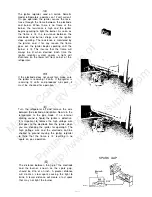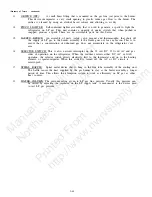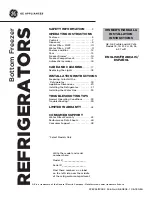
Before You Change
That
Cooling Unit
PART I. PROPER DIAGNOSIS
Cooling units are sometimes diagnosed as being
defective when the actual problem is something
else. Cooling units are expensive to replace, so
it is important to make the correct diagnosis. By
using the proper test procedures, you can eliminate
all other possibilities before condemning the
cooling unit.
Any time the cooling unit is a possible suspect,
use the following step-by-step procedure before
replacing it.
A.
1.
2.
3.
4.
PRELIMINARY CHECKS
Check for an ammonia smell around the
cooling unit and inside the refrigerator.
This could indicate a possible refrigerant
leak. Check for any deposits of yellow
powder on the tubing which will sometimes
form around the area of a leak. NOTE: A
yellow deposit in the area of the fill valve
could be due to splashing of refrigerant
during manufacture, and would not indicate
a leak.
Determine if the refrigerator works on one
heat source but not another by testing it in
the alternate modes. Also, ask the customer
if he gets better cooling results from one
energy source than another. If this is true,
it indicates the problem is NOT in the cooling
unit.
Make sure the refrigerator is level. Sometimes
the vehicle is level but the refrigerator is
not, due to improper installation. Place a
level on the bottom of the freezer compart-
ment and check side-to-side and front-to-back
levels (see FIG. Al). Use a mirror, if
necessary to read the level.
Carefully check door gaskets for proper
seal. A leaking gasket can allow enough
warm air inside the refrigerator to overcome
most of the cooling being produced.
D-9-l 0
REFRlGERATOR
BULLETIN
R61/7A
DEC.
1987
For a simple method to check gaskets, close
the door on a dollar bill, then pull the dollar
bill out. If no resistance is felt, the gasket
is not sealing properly. This should be done
on all four sides of the door.
FIG. Al
CHECK LEVEL
BOTH WAY.
5.
Check the venting system to insure that
ample air flow is provided at the back of
the refrigerator.
A. Check for, and remove, any restrictions
in the vents, such as filters installed by
the customer, bird nests in the roof
vent, or smashed louvers in the wall
vents (see FIG. A2).
B. Make sure the correct roof vent has
been installed. Larger models such as
RM100, 760, 761, 1300, 1303, 2600, 2800,
2802, 3600, 3800, 3802 and 4801, require
a 5” X 24” opening for the roof vent
Smaller models will also use the 5”
24” roof opening. To check this, measure
the actual opening in the roof - DO
NOT measure the roof vent itself. See
FIG. A2.
Manual
Compliments
of
Northwest
RV
Supply
Printed
From
http://www.nwrvsupply.com












































